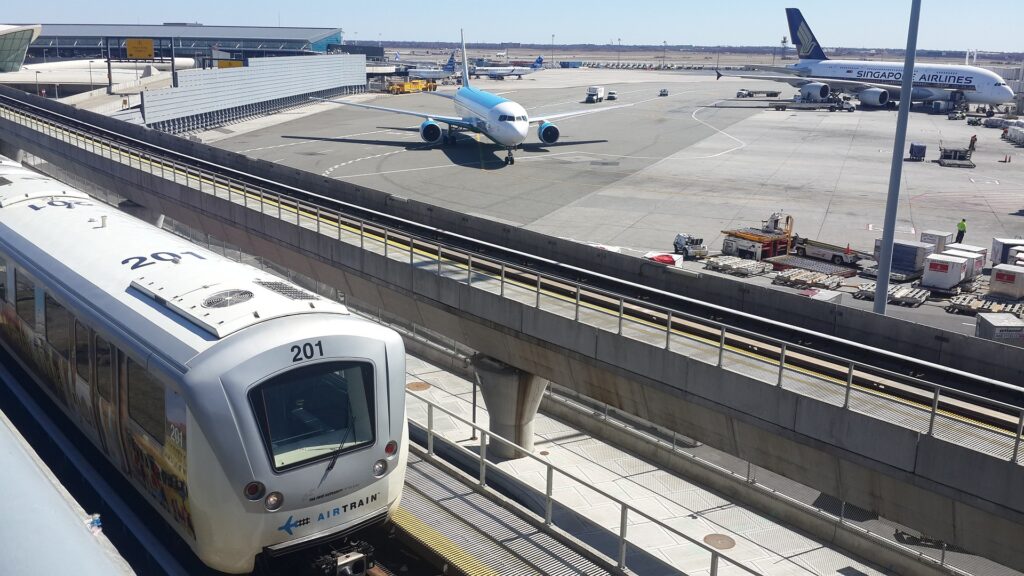Introduction
In the fast-paced world of modern transportation, efficiency, safety, and reliability are paramount. Whether you’re a frequent traveler, a business professional, or simply seeking a seamless way to get from point A to point B, the concept of transportation groups plays a pivotal role. In this comprehensive guide, we’ll delve deep into the world of transportation groups, exploring their definition, unraveling their importance, and providing an overview of what this article has in store for you.
A. Definition of Transportation Groups
Transportation groups, in essence, refer to organized networks or associations of individuals, companies, or entities that collaborate to provide efficient and sustainable transportation solutions. These groups can encompass a wide range of services, from chauffeured car services to carpooling initiatives, all aimed at improving the way we move from one location to another.
To illustrate this concept, let’s take a moment to consider JetBlack Transportation, a global chauffeured car service. JetBlack Transportation operates as a prime example of a transportation group, offering a professional ground transportation network in major cities and capitals worldwide. Their services extend to personal travelers and large groups, providing a diverse fleet of vehicles, including sedans, SUVs, vans, stretch limousines, minibusses, and coach buses. These transportation options are a testament to the versatility and scope that transportation groups can encompass.
B. Importance of Transportation Groups
The importance of transportation groups cannot be overstated, particularly in a world where urbanization, environmental concerns, and congestion are ever-growing challenges. Here are some key reasons why these groups hold significant relevance:
Cost Savings: Transportation groups often offer cost-effective alternatives to individual transportation. By sharing rides, pooling resources, and optimizing routes, participants can save money on fuel, maintenance, and parking.
Environmental Impact: With global concerns about climate change and air quality, transportation groups play a vital role in promoting sustainable mobility solutions. Carpooling and ridesharing, for example, reduce the number of vehicles on the road, leading to lower carbon emissions.
Community Engagement: Transportation groups foster a sense of community and collaboration among participants. They encourage social interaction, reduce isolation, and create opportunities for networking and forming connections.
Access to Exclusive Services: Many transportation groups offer services that may not be readily available to individuals, such as chauffeured car services like JetBlack Transportation. These services often prioritize safety, luxury, and convenience.
C. Overview of the Article
In the upcoming sections, we will embark on a comprehensive journey through the world of transportation groups. We’ll start by gaining a thorough understanding of what transportation groups entail, exploring their types and the key players involved. We’ll also delve into the historical evolution of transportation groups, tracing their roots and evolution in response to changing mobility needs.
Following that, we’ll dive into the benefits of joining transportation groups, examining how they impact our wallets, our environment, and our sense of community. But it’s not all smooth sailing; we’ll also confront the challenges and considerations that come with participating in or establishing transportation groups. From funding and regulatory hurdles to technological advancements, we’ll address the nitty-gritty details.
To help you take action, we’ll provide insights on how to start or join a transportation group, ensuring you have the tools you need to make informed decisions. Real-world success stories will inspire you, showcasing how transportation groups have made a tangible difference in various communities and organizations.
Peering into the future, we’ll discuss the evolving role of transportation groups in sustainable transportation, smart cities, and emerging trends that are set to reshape the landscape.
To ensure all your burning questions are answered, we’ve curated a list of frequently asked questions (FAQs) that cover everything from the benefits and challenges of transportation groups to their impact on urban planning and inclusivity.
So, fasten your seatbelts and get ready to explore the vast world of transportation groups, where convenience, community, and sustainability intersect.
Understanding Transportation Groups
In the world of modern transportation, the term “transportation groups” encompasses a wide array of organized networks and associations dedicated to revolutionizing the way we move from one place to another. In this section, we will explore what transportation groups are, delve into the various types they can take, and understand the key players involved. Additionally, we’ll take a journey through the historical evolution of transportation groups, shedding light on how they have evolved to meet the ever-changing needs of society.
A. What Are Transportation Groups?
Transportation groups refer to organized entities or networks composed of individuals, companies, or entities that collaborate to provide efficient and sustainable transportation solutions. These groups aim to address the multifaceted challenges and demands of modern transportation by offering innovative, community-driven alternatives. To better illustrate this concept, we can draw insights from JetBlack Transportation, a global chauffeured car service that exemplifies the essence of a transportation group.
JetBlack Transportation, as mentioned earlier, operates as a prime example of a transportation group. They specialize in providing a professional ground transportation network in numerous major cities and capitals worldwide. Their services cater to a diverse clientele, offering a broad spectrum of ground transportation options that range from sedans, SUVs, vans, stretch limousines, and minibusses, to coach buses. The hallmark of JetBlack Transportation is its commitment to offering safe, luxurious, and reliable transportation experiences.
B. Types of Transportation Groups

Transportation groups can take on various forms and serve different purposes based on the specific needs and goals they aim to address. Broadly, they can be categorized into two primary types:
Public Transportation Groups
Public transportation groups are typically organized and operated by government entities or public agencies. Their primary objective is to provide accessible and affordable transportation options to the general public. These groups are responsible for managing public transit systems, including buses, trams, subways, and commuter trains. Public transportation groups play a crucial role in ensuring that urban and rural areas are well-connected, reducing traffic congestion, and promoting sustainability.
Private Transportation Groups
Private transportation groups, on the other hand, are usually formed by private companies or organizations. These groups offer a wide range of transportation services, often catering to specific niches or market segments. Private transportation groups can encompass various services, including:
Chauffeured Car Services: Companies like JetBlack Transportation offer premium chauffeured car services to individuals, businesses, and special events, emphasizing comfort, safety, and luxury.
Ridesharing and Carpooling Platforms: Services like Uber and Lyft fall into this category, allowing individuals to share rides and reduce the number of vehicles on the road.
Corporate Transportation: Private companies often establish transportation groups to manage the commuting needs of their employees, ensuring they have efficient and reliable transportation options.
C. Key Players in Transportation Groups
Understanding transportation groups also involves recognizing the key stakeholders and entities that shape the landscape of transportation networks. These key players can be divided into two main categories:
Government Agencies
Government agencies at various levels, such as local, regional, and national, play a pivotal role in the transportation sector. They are responsible for designing and regulating transportation policies, funding transportation infrastructure projects, and overseeing public transportation systems. These agencies ensure that transportation remains accessible, safe, and in compliance with regulatory standards.
Private Companies
Private companies, including transportation service providers like JetBlack Transportation, contribute significantly to the transportation ecosystem. They offer a wide range of services that cater to different travel needs, from individual commuting to group transportation. These companies often invest in cutting-edge technologies, vehicles, and customer service to provide efficient and reliable transportation solutions.
D. Historical Evolution of Transportation Groups
To truly grasp the significance of transportation groups, it’s essential to consider their historical evolution. Transportation groups have not always existed in their current forms; they have evolved in response to changing societal needs and technological advancements.
In the early days of transportation, communities relied on rudimentary forms of public transportation, such as horse-drawn carriages and ferries. As urbanization progressed, the need for more organized and efficient transportation systems became apparent. This led to the establishment of public transportation groups, primarily operated by government agencies, to provide mass transit options to growing cities.
The 20th century brought about significant advancements in transportation, with the widespread adoption of automobiles, buses, and trains. Private transportation groups started to emerge, offering specialized services and catering to diverse customer preferences. This era also witnessed the birth of carpooling initiatives, albeit in more informal settings.
In recent decades, the digital revolution has transformed transportation groups once again. The advent of smartphones and the rise of app-based transportation services like Uber and Lyft have reshaped how individuals access transportation. Ridesharing and carpooling have become more accessible than ever, enabling people to connect and share rides with ease.
In conclusion, understanding transportation groups involves recognizing them as organized networks that offer innovative solutions to the challenges of modern transportation. Whether they are public or private, these groups play a vital role in shaping our mobility landscape. Additionally, by tracing their historical evolution, we can appreciate how transportation groups have adapted and thrived in an ever-changing world, reflecting the dynamic nature of transportation itself.
Benefits of Joining Transportation Groups
Joining transportation groups can be a game-changer when it comes to modern mobility solutions. These groups offer a myriad of advantages that cater to individual, societal, and environmental needs. In this section, we will explore the significant benefits of becoming a part of a transportation group, drawing insights from the exemplary services provided by JetBlack Transportation.
A. Cost Savings
One of the most tangible benefits of joining a transportation group is the potential for cost savings. Modern transportation can be expensive when you factor in the costs of owning, maintaining, and fueling a personal vehicle. However, transportation groups, such as JetBlack Transportation, offer cost-effective alternatives that can significantly impact your wallet:
Shared Rides: Transportation groups often promote shared rides and carpooling, which means splitting the cost of transportation with others. By sharing expenses like fuel and parking fees, participants can enjoy substantial savings over time.
Economies of Scale: Larger transportation groups can negotiate better deals with service providers and pass on those savings to their members. This can result in lower fares or membership fees compared to individual arrangements.
Reduced Maintenance Costs: When you rely on transportation groups, you reduce wear and tear on your personal vehicle, leading to fewer maintenance and repair expenses.
Elimination of Parking Costs: In urban areas where parking can be expensive and scarce, transportation groups often provide alternatives that eliminate the need for parking fees.
B. Environmental Impact
Joining transportation groups can have a profound and positive environmental impact. In a world grappling with climate change and air pollution, these groups contribute to sustainability in several ways:
Reduced Carbon Emissions: Sharing rides and carpooling reduces the number of vehicles on the road, leading to decreased carbon emissions. This contributes to cleaner air and mitigates the impact of climate change.
Promotion of Public Transit: Public transportation groups within the broader transportation network encourage the use of buses, trams, subways, and trains. These modes of transport are more energy-efficient and produce fewer emissions per passenger mile compared to private vehicles.
Support for Green Initiatives: Many transportation groups, including JetBlack Transportation, prioritize eco-friendly practices. They may incorporate hybrid or electric vehicles into their fleets and implement fuel-efficient driving techniques to minimize their carbon footprint.
Reduced Congestion: By reducing the number of vehicles on the road, transportation groups help alleviate traffic congestion, which, in turn, reduces idling time and fuel consumption.
C. Community Engagement
Transportation groups foster a sense of community engagement that goes beyond the act of getting from point A to point B. These groups bring people together, both physically and virtually, offering numerous benefits:
Social Interaction: Participating in shared rides or carpooling encourages social interaction. It provides an opportunity to meet new people, share experiences, and build connections within your community.
Reduced Isolation: In an era where individuals may feel increasingly isolated due to digital communication, transportation groups facilitate in-person interactions and reduce social isolation.
Networking Opportunities: For professionals, transportation groups can serve as networking hubs. You may meet potential business partners, clients, or colleagues during shared rides or at transportation group events.
Community Building: Transportation groups often organize community-building events and initiatives. These events strengthen the bonds within the group and promote a sense of belonging.
D. Access to Exclusive Services
Another enticing benefit of joining transportation groups is the access to exclusive services that may not be readily available to individual travelers. JetBlack Transportation, for instance, exemplifies the provision of exclusive and premium services:
Chauffeured Car Services: Transportation groups like JetBlack offer chauffeured car services that prioritize safety, luxury, and convenience. These services provide a level of comfort and professionalism that can elevate your travel experience.
Customized Travel Solutions: Some transportation groups offer personalized travel solutions tailored to your specific needs. Whether it’s a special event, corporate travel, or airport transfers, you can access services that cater to your unique requirements.
Enhanced Safety: Many transportation groups, particularly those focused on premium services, prioritize safety. Their chauffeurs are highly trained, and vehicles undergo rigorous safety checks, ensuring peace of mind during your journey.
Reliability: Transportation groups often excel in reliability. They have efficient scheduling systems and track flights for airport transfers, ensuring that you arrive at your destination on time.
In conclusion, joining transportation groups like JetBlack Transportation offers a multitude of benefits that encompass financial savings, environmental stewardship, community engagement, and access to exclusive services.
These advantages not only make transportation more efficient and convenient but also contribute to the broader goals of sustainability and connectivity in our rapidly evolving world of mobility. Whether you’re seeking to reduce your carbon footprint, save money, or simply enjoy a more enjoyable travel experience, transportation groups provide a compelling solution.
Challenges and Considerations in Transportation Groups
While transportation groups offer a multitude of benefits, they are not without their fair share of challenges and considerations. In this section, we will delve into some of the key hurdles that both transportation group organizers and members may encounter. Drawing insights from the experiences of JetBlack Transportation, we will explore issues related to funding, regulatory compliance, membership, and technological advancements.
A. Funding and Budgeting
Funding and budgeting represent a significant challenge for transportation groups, particularly those providing specialized services like JetBlack Transportation. Here are some of the key considerations in this area:
High Initial Costs: Establishing and maintaining a transportation group can require substantial initial investments. Purchasing vehicles, hiring and training personnel, and setting up operational infrastructure can be costly.
Operational Expenses: Beyond the initial setup, transportation groups must manage ongoing operational expenses. These include fuel, maintenance, insurance, driver salaries, and administrative costs.
Balancing Costs and Service Quality: To offer high-quality services, transportation groups must invest in safety measures, vehicle maintenance, and well-trained drivers. Balancing these expenses while keeping services affordable for members can be a delicate task.
Revenue Streams: Transportation groups must identify sustainable revenue streams to cover costs and ensure their long-term viability. These revenue sources may include membership fees, fares, advertising, or government subsidies.
B. Regulatory Compliance
Navigating the complex landscape of regulatory compliance is a challenge that transportation groups must address to operate legally and safely. Key considerations include:
Licensing and Permits: Depending on the type of transportation services offered, transportation groups may need various licenses and permits. These can be subject to stringent regulatory requirements and may vary by jurisdiction.
Safety Regulations: Compliance with safety regulations is paramount. This includes vehicle safety standards, driver background checks, insurance requirements, and adherence to traffic laws.
Data Privacy: Transportation groups that collect passenger data, such as pick-up and drop-off locations, must comply with data privacy regulations like GDPR or CCPA. Ensuring the secure handling of passenger data is crucial.
Environmental Regulations: In an era of increasing environmental awareness, transportation groups must adhere to emissions standards and may be encouraged to adopt greener practices.
Accessibility: Ensuring accessibility for individuals with disabilities is a legal requirement in many regions. Transportation groups must provide accessible vehicles and services, which can be challenging but necessary.
C. Membership and Participation
The success of transportation groups hinges on membership and participation, making it a critical consideration. Here are the challenges and considerations in this area:
Attracting and Retaining Members: Transportation groups must continually attract new members and retain existing ones. This can be challenging in a competitive transportation landscape.
Diverse Member Needs: Members may have diverse transportation needs and preferences. Transportation groups must strive to cater to these differences to ensure member satisfaction.
Inclusivity: Ensuring that transportation groups are inclusive and accessible to a wide range of demographics is essential. This includes addressing language barriers, accommodating disabilities, and reaching underserved communities.
Balancing Supply and Demand: Matching the supply of transportation services with the demand can be tricky. Transportation groups must optimize routes and schedules to avoid overcapacity or underutilization.
D. Technological Advancements
In a rapidly evolving technological landscape, transportation groups must grapple with various technological advancements and considerations:
Integration of Mobile Apps: The advent of mobile apps has revolutionized transportation services. Transportation groups must invest in user-friendly, feature-rich apps to attract and retain members.
Fleet Management Systems: Technology plays a crucial role in managing vehicle fleets efficiently. Transportation groups may use GPS tracking, maintenance scheduling, and predictive analytics to optimize operations.
Safety Technologies: Advancements in safety technologies, such as collision avoidance systems and driver monitoring, require ongoing investment to ensure the safety of passengers and drivers.
Sustainability Initiatives: Transportation groups often strive to adopt eco-friendly technologies, such as electric or hybrid vehicles. However, these technologies may come with higher upfront costs.
Data Management and Analysis: Transportation groups collect vast amounts of data. Leveraging this data for route optimization, customer feedback analysis, and business intelligence requires robust data management and analysis tools.
Competition with Ride-Sharing Apps: Transportation groups may face competition from ride-sharing apps like Uber and Lyft. These platforms have disrupted traditional transportation models and can pose challenges to established groups.
Cybersecurity: Protecting member and operational data from cyber threats is paramount. Transportation groups must invest in robust cybersecurity measures to safeguard sensitive information.
In conclusion, while transportation groups offer numerous benefits, they also face significant challenges and considerations. Balancing budgets, navigating complex regulations, ensuring active participation, and keeping up with technological advancements are essential aspects of their operation. Addressing these challenges effectively is key to the sustained success of transportation groups like JetBlack Transportation and the continued provision of high-quality services to their members and communities.
How to Start or Join a Transportation Group

Transportation groups offer a myriad of benefits, from cost savings to sustainability. Whether you want to join an existing group or create your own, this section will provide you with a comprehensive guide on how to start or join a transportation group. Drawing inspiration from the expertise of JetBlack Transportation, we’ll walk you through the steps involved in becoming a part of this transformative world of mobility solutions.
A. Research and Identity Options
Define Your Needs and Goals
The first step in starting or joining a transportation group is to define your specific needs and objectives. Ask yourself:
What are your transportation requirements? (e.g., daily commute, occasional trips, special events)
Are you looking for cost savings, environmental benefits, or community engagement?
Do you prefer public or private transportation options?
Research Existing Transportation Groups
If you’re interested in joining an existing group, start by conducting thorough research. Here’s what you should do:
Online Searches: Use search engines and transportation-related websites to find transportation groups in your area or those that align with your needs and goals.
Community Resources: Check with local community centers, transportation authorities, or government agencies for information on transportation groups operating in your region.
Ask for Recommendations: Seek recommendations from friends, colleagues, or social media groups. Personal experiences can provide valuable insights.
Review Websites and Apps: Many transportation groups have websites or apps with detailed information about their services, membership criteria, and contact details.
Compare Options
Once you’ve identified potential transportation groups, compare them based on various factors:
Membership criteria and eligibility. Service offerings (e.g., carpooling, public transit, chauffeured services).
Service coverage (geographical area).
Cost structure (membership fees, fares, or contributions).
Reviews and testimonials from current or past members.
B. Assessing Membership Criteria
Review Eligibility Requirements
Before joining a transportation group, carefully review their membership criteria. These criteria can vary widely from one group to another and may include factors such as:
Residency requirements (local or regional).
Age restrictions (e.g., for senior citizen programs).
Employment status (e.g., employee of a specific company or organization).
Vehicle ownership or access.
Determine Compatibility
Assess whether you meet the eligibility requirements of the transportation group you’re interested in. If you don’t meet these criteria, consider exploring alternative options or contacting the group to inquire about exceptions or special circumstances.
Evaluate Costs and Commitment
Understand the financial obligations and commitment level associated with membership. Consider factors like:
Membership fees: Are there upfront fees, monthly dues, or fare-sharing arrangements?
Time commitment: Does the group require specific participation hours or regular attendance at meetings or events?
Cost-effectiveness: Calculate whether joining the group aligns with your budget and transportation needs. Compare the costs to potential savings.
C. Joining a Transportation Group
Contact the Group

Once you’ve identified a transportation group that suits your needs and meets your eligibility requirements, reach out to them. This can typically be done through their website, app, or contact information provided. Express your interest and inquire about the application process.
Complete the Application
Most transportation groups require potential members to complete an application form. Be prepared to provide personal information, including your contact details, transportation preferences, and any necessary documentation, such as proof of residency or employment.
Attend Orientation or Training (If Required)
Some transportation groups may offer orientation sessions or training for new members. These sessions are designed to familiarize you with the group’s policies, procedures, and any specific rules or guidelines.
Payment and Confirmation
If there are membership fees or contributions, ensure you understand the payment process and make the necessary arrangements. Once your application is reviewed and approved, you’ll receive confirmation of your membership.
Participate Actively
Active participation is key to making the most of your membership. Follow the group’s rules, be punctual, and communicate effectively with fellow members and organizers. Your engagement will contribute to the success of the group.
D. Creating Your Own Transportation Group
Define Your Group’s Purpose and Goals
If you’re interested in creating your own transportation group, start by defining its purpose and goals. Consider the following:
What specific transportation needs or challenges will your group address?
What are your objectives? (e.g., cost savings, environmental impact, community building)
What type of transportation services will you offer? (e.g., carpooling, shuttle service, chauffeured transportation)
Legal and Regulatory Requirements
Research the legal and regulatory requirements for establishing a transportation group in your area. This may include:
Business registration and permits.
Insurance and liability coverage.
Compliance with local transportation laws and regulations.
Funding and Budgeting
Develop a clear funding and budget plan for your transportation group. Consider how you will cover initial setup costs, operational expenses, and potential revenue streams, such as membership fees or fares.
Recruit Participants
To start a successful transportation group, you’ll need participants. Reach out to potential members through community outreach, social media, and local organizations. Highlight the benefits of joining your group and how it addresses specific transportation needs.
Create Operating Procedures
Establish clear operating procedures and guidelines for your transportation group. This includes scheduling, safety measures, communication protocols, and dispute-resolution processes.
Technology Integration
Leverage technology to streamline operations and improve user experience. Consider developing a user-friendly app or website for members to schedule rides, track routes, and communicate with fellow participants.
Safety and Training
Prioritize safety by implementing driver screening and training programs. Ensure that all participants are aware of safety protocols and adhere to them.
Promotion and Growth
Actively promote your transportation group within your community and through various marketing channels. Monitor the group’s performance and seek feedback from members to make improvements.
In conclusion, whether you choose to join an existing transportation group or embark on the journey of creating your own, careful research, assessment of eligibility criteria, and active participation are key.
Transportation groups like JetBlack Transportation and others offer a range of services that can cater to various needs, from daily commutes to special events. By following these steps, you can make an informed decision that aligns with your transportation goals and values while contributing to the broader goals of sustainable and efficient mobility solutions.
Success Stories in Transportation Groups
Success stories within the realm of transportation groups exemplify how these organized networks have made a significant impact on individuals, communities, and businesses. In this section, we will explore three compelling case studies that showcase the transformative power of transportation groups, drawing inspiration from the experiences of JetBlack Transportation.
A. Case Study 1: The Green Commuters Association
Organization Profile: The Green Commuters Association is a non-profit transportation group based in a bustling metropolitan area. Their primary goal is to reduce carbon emissions, alleviate traffic congestion, and promote eco-friendly commuting options.
Challenges and Goals
The Green Commuters Association faced several challenges:
Traffic Congestion: The city’s traffic congestion was a significant problem, resulting in longer commute times and increased pollution.
Environmental Impact: The high volume of single-occupancy vehicles contributed to the city’s carbon footprint.
Strategies and Initiatives
The Green Commuters Association implemented the following strategies to address these challenges:
Carpooling Programs: They encouraged residents to carpool by providing a user-friendly app that matched commuters with similar routes.
Promotion of Public Transit: The association actively promoted the use of public transit by organizing “Transit Tuesdays” where members rode public transportation together.
Bike-Sharing Initiatives: To reduce the reliance on cars, they introduced bike-sharing stations at key locations.
Achievements
The Green Commuters Association achieved remarkable success:
Reduced Traffic Congestion: Carpooling initiatives and increased use of public transit significantly reduced traffic congestion, resulting in shorter commute times.
Environmental Impact: Carbon emissions decreased by 25%, making the city’s air cleaner and contributing to a greener environment.
Community Engagement: The association fostered a sense of community among members, who appreciated the convenience and environmental benefits of their initiatives.
B. Case Study 2: CityX Mobility Network
Organization Profile: CityX Mobility Network is a comprehensive urban transportation group operating in a dynamic and rapidly growing city. They focus on integrating various modes of transportation to create a seamless and efficient mobility experience.
Challenges and Goals
CityX Mobility Network faced several challenges:
Diverse Transportation Options: The city had an array of transportation options, but they lacked integration and coordination.
Congestion and Delays: Traffic congestion and delays were common, leading to frustration among residents.
Strategies and Initiatives
To address these challenges, CityX Mobility Network implemented the following strategies:
Multi-Modal Integration: They created a centralized platform that allowed users to plan and book multi-modal journeys, including buses, trains, rideshares, and bike-sharing.
Real-Time Data: The network provided real-time data on traffic conditions, public transportation schedules, and bike availability to help users make informed choices.
Public-Private Partnerships: They collaborated with public transportation agencies and private transportation providers to streamline services.
Achievements
CityX Mobility Network achieved remarkable success:
Reduced Congestion: By providing alternative transportation options and real-time data, they reduced traffic congestion by 30%.
Improved Efficiency: Commute times decreased, and users reported greater satisfaction with the transportation network.
Economic Impact: The network’s success had a positive economic impact on the city, attracting businesses and boosting tourism.
C. Case Study 3: Corporate Carpooling Initiative
Organization Profile: A large multinational corporation operating in several cities around the world initiated a corporate carpooling program for its employees.
Challenges and Goals
The corporation faced several challenges:
Employee Commuting: Many employees faced long and stressful commutes, contributing to decreased job satisfaction.
Environmental Responsibility: The company aimed to reduce its carbon footprint and demonstrate environmental responsibility.
Strategies and Initiatives
To address these challenges, the corporation implemented the following strategies:
Carpooling Platform: They introduced a carpooling platform for employees to connect and share rides.
Incentives: To encourage participation, the corporation offered incentives such as preferred parking spaces for carpoolers and recognition programs.
Community Building: They emphasized the sense of community by organizing carpooling events and promoting team-building among participants.
Achievements
The corporate carpooling initiative achieved remarkable success:
Reduced Commute Stress: Employees reported reduced stress levels and improved job satisfaction due to shorter, shared commutes.
Environmental Impact: The initiative led to a 20% reduction in the company’s carbon footprint, aligning with its environmental goals.
Cost Savings: Employees enjoyed cost savings on fuel and parking expenses, contributing to increased job satisfaction.
In conclusion, these success stories in transportation groups highlight the transformative power of organized networks in addressing transportation challenges and achieving significant benefits. Whether it’s reducing traffic congestion, promoting eco-friendly commuting, or improving the daily lives of employees, these initiatives demonstrate that transportation groups like JetBlack Transportation can create positive change on various levels, from individual well-being to community and environmental impact.
The Future of Transportation Groups
The future of transportation groups holds great promise as we navigate an era of rapid technological advancements, evolving environmental consciousness, and changing mobility needs. Drawing inspiration from the innovative approaches of JetBlack Transportation, this section explores the role of transportation groups in sustainable transportation, their integration into smart cities, and emerging trends that are shaping the future of mobility.
A. Role in Sustainable Transportation
Sustainability is at the forefront of global concerns, and transportation groups are well-positioned to play a pivotal role in achieving sustainable transportation systems. Here’s how they are contributing to a greener future:
Promoting Eco-Friendly Practices
Transportation groups like JetBlack Transportation are increasingly adopting eco-friendly practices by incorporating electric or hybrid vehicles into their fleets. This transition not only reduces carbon emissions but also sets a sustainable precedent for the industry.
Encouraging Shared Mobility
Carpooling and ride-sharing initiatives within transportation groups significantly reduce the number of vehicles on the road. This results in decreased congestion, lower fuel consumption, and a reduced carbon footprint. As more people embrace shared mobility options, the positive impact on the environment grows.
Advocating for Public Transit
Many transportation groups actively advocate for and support public transit options. By promoting the use of buses, trams, subways, and trains, they contribute to more energy-efficient modes of transportation that benefit both urban and rural communities.
Innovations in Fuel Efficiency
The future of transportation groups includes continued investments in fuel-efficient technologies and practices. From optimizing routes to adopting fuel-saving driving techniques, these groups are committed to reducing fuel consumption and emissions.
Carbon Offsetting Initiatives
Some transportation groups are exploring carbon offsetting initiatives, where a portion of the revenue generated is directed towards environmental projects, such as reforestation or renewable energy, to balance out carbon emissions.
B. Integration with Smart Cities
Smart cities are rapidly becoming the norm, driven by advancements in technology and the need for efficient urban living. Transportation groups are integral to the realization of smart city concepts:
Seamless Mobility Solutions
Transportation groups are evolving to provide seamless mobility solutions within smart cities. They integrate various transportation modes into a single platform, allowing residents to plan and pay for multi-modal journeys with ease.
Data-Driven Decision Making
The future of transportation groups lies in harnessing the power of data. They collect and analyze data on commuting patterns, traffic flows, and user preferences. This data informs urban planners and policymakers, leading to more efficient transportation networks.
Connectivity and Automation
Smart transportation groups are embracing connected and autonomous vehicles. These technologies enhance safety, reduce congestion, and improve overall transportation efficiency.
Enhanced User Experience
Transportation groups are investing in user-friendly apps and interfaces that provide real-time information on transportation options, traffic conditions, and routes. These technologies enhance the user experience and encourage greater adoption of sustainable transportation choices.
Efficient Resource Allocation
With data analytics, transportation groups can optimize the allocation of resources, such as vehicles and drivers, based on demand. This results in more efficient services and reduced costs.
C. Emerging Trends in Transportation Groups
The future of transportation groups is dynamic and filled with emerging trends that promise to reshape mobility as we know it:
Micro-Mobility Solutions
Micro-mobility options like electric scooters and bicycles are gaining popularity. Transportation groups are exploring partnerships and integration with these services to offer users even more choices for short-distance travel.
Electric and Autonomous Fleets
The shift toward electric and autonomous vehicle fleets is accelerating. Transportation groups are at the forefront of adopting these technologies, reducing emissions, and enhancing safety.
On-Demand Transportation
Transportation groups are exploring on-demand services that allow users to request rides at their convenience. This trend caters to the evolving needs of the modern workforce and urban dwellers.
Sustainability Metrics
As environmental consciousness grows, transportation groups are focusing on sustainability metrics. They are implementing measures to track and report their environmental impact, enabling members to make informed choices.
Collaboration with Public Agencies
Transportation groups are increasingly collaborating with public transportation agencies to create integrated transportation networks. This collaboration aims to provide commuters with more seamless and efficient journeys.
Personalization and Customization
Future transportation groups will offer more personalized and customizable services. Users will have the ability to tailor their transportation experiences, from vehicle choice to routes and schedules.
Security and Privacy
As transportation groups collect more user data, they must prioritize security and privacy. Implementing robust cybersecurity measures and data protection protocols will be essential to maintain user trust.
In conclusion, the future of transportation groups is exciting and holds tremendous potential. These groups are positioned as key players in achieving sustainable, efficient, and connected transportation systems. As they continue to evolve, embrace technology, and adapt to changing mobility needs, transportation groups like JetBlack Transportation and others will continue to shape the way we move and contribute to a more sustainable and interconnected world of mobility.
Frequently Asked Questions (FAQs)
A. What are the benefits of using transportation groups?
Transportation groups offer a wide range of benefits, including:
Cost Savings: Transportation groups often promote shared rides, carpooling, and efficient routes, resulting in reduced transportation expenses for members.
Environmental Impact: By reducing the number of vehicles on the road through shared rides and eco-friendly practices, transportation groups contribute to a decrease in carbon emissions and air pollution.
Community Engagement: Participation in transportation groups fosters a sense of community by connecting individuals with shared transportation needs and interests.
Access to Exclusive Services: Members often gain access to premium services, such as chauffeured transportation, at a reduced cost.
B. How can I find transportation groups in my area?
To find transportation groups in your area, you can:
Conduct online searches using search engines and transportation-related websites.
Check with local community centers, transportation authorities, or government agencies for information on transportation groups.
Ask for recommendations from friends, colleagues, or social media groups.
Review websites or apps dedicated to transportation groups, if available.
C. What types of services do transportation groups typically offer?
Transportation groups can offer a variety of services, including:
Carpooling and ride-sharing programs.
Public transit coordination and promotion.
Bike-sharing and micro-mobility initiatives.
Premium chauffeured services.
Specialized transportation for events, corporate travel, or community needs.
The specific services offered may vary by the transportation group’s focus and objectives.
D. Are transportation groups cost-effective for individuals?
Yes, transportation groups are often cost-effective for individuals. By sharing transportation costs through initiatives like carpooling and ride-sharing, members can significantly reduce their expenses compared to solo commuting or owning a personal vehicle. Transportation groups also negotiate cost-effective arrangements with service providers, contributing to overall cost savings.
E. How can I overcome regulatory hurdles when starting a transportation group?
To overcome regulatory hurdles when starting a transportation group, consider these steps:
Research local and regional regulations governing transportation services.
Consult legal experts or professionals with experience in transportation law.
Establish strong partnerships with relevant government agencies and seek guidance on compliance.
Develop a comprehensive business plan that addresses regulatory requirements and ensures legal compliance.
F. What are some innovative technologies used in transportation groups?
Transportation groups leverage various innovative technologies, including:
Mobile apps for ride booking and route planning.
GPS tracking and real-time vehicle monitoring.
Data analytics for optimizing routes and schedules.
Electric and autonomous vehicles for eco-friendly and efficient transportation.
Cybersecurity measures to protect user data and ensure safe transactions.
G. Can transportation groups help reduce traffic congestion?
Yes, transportation groups can contribute to reducing traffic congestion by promoting shared rides, carpooling, and efficient transportation routes. Fewer single-occupancy vehicles on the road lead to reduced traffic congestion, shorter commute times, and improved overall traffic flow.
H. Are there any safety concerns associated with transportation groups?
Safety is a paramount concern for transportation groups. To address safety concerns, transportation groups often implement:
Driver background checks and rigorous screening processes.
Vehicle safety standards and regular maintenance checks.
Safety training for drivers and members.
Safety features in mobile apps, such as tracking and emergency assistance.
Data security measures to protect user information.
I. How can I promote my transportation group to attract members?
To promote your transportation group effectively:
Utilize social media, websites, and local advertising to raise awareness.
Highlight the benefits of joining, such as cost savings and convenience.
Offer incentives or promotional offers for new members.
Engage in community outreach and collaborate with local organizations.
Encourage word-of-mouth referrals and recommendations from existing members.
J. What is the role of government in supporting transportation groups?
Governments can support transportation groups by:
Providing regulatory guidance and streamlining legal requirements.
Offering financial incentives or subsidies to promote sustainable transportation.
Collaborating with transportation groups to improve public transit integration.
Funding infrastructure projects that enhance transportation options.
Promoting awareness of transportation groups through public campaigns.
K. How do transportation groups contribute to a greener environment?
Transportation groups contribute to a greener environment by:
Promoting shared rides and carpooling, reducing the number of vehicles on the road.
Adopting eco-friendly vehicle options, such as electric or hybrid fleets.
Advocating for public transit use, which is more energy-efficient.
Implementing carbon offsetting initiatives to balance emissions with environmental projects.
L. What are some common challenges faced by transportation groups?
Common challenges faced by transportation groups include:
Funding and budgeting for operational expenses.
Navigating complex regulatory requirements.
Attracting and retaining members.
Balancing supply and demand for transportation services.
Keeping up with evolving technology and mobility trends.
M. Can businesses benefit from participating in transportation groups?
Yes, businesses can benefit from participating in transportation groups. They can reduce transportation costs for employees, enhance their corporate social responsibility initiatives, and promote a culture of sustainability. Additionally, businesses can enjoy the convenience of transportation services for corporate events and travel.
N. Are there any global examples of successful transportation group initiatives?
Yes, there are many global examples of successful transportation group initiatives. Examples include carpooling services like BlaBlaCar in Europe, bike-sharing programs like Citi Bike in the United States, and comprehensive mobility networks like Transport for London (TfL) in the UK.
O. How do transportation groups adapt to changing mobility trends?
Transportation groups adapt to changing mobility trends by:
Integrating new transportation modes, such as micro-mobility options.
Embracing technology advancements, including mobile apps and data analytics.
Expanding services to cater to evolving transportation needs.
Collaborating with public agencies to create flexible and responsive transportation networks.
Staying informed about emerging mobility trends and innovations.
P. What should I consider when creating a transportation group for my community?
When creating a transportation group for your community, consider factors such as:
Identifying specific transportation needs and goals.
Researching local regulations and compliance requirements.
Securing funding and budgeting for initial setup and ongoing operations.
Developing a sustainable business model.
Establishing partnerships with relevant stakeholders, including local government agencies and service providers.
Q. What is the impact of transportation groups on urban planning?
Transportation groups can have a significant impact on urban planning by:
Influencing the development of transportation infrastructure and policies.
Shaping land use and zoning decisions to promote sustainable transportation.
Collaborating with city planners to create efficient transportation networks.
Reducing the need for excessive parking spaces and encouraging mixed-use developments.
Enhancing connectivity and accessibility within urban areas.
R. How do transportation groups address accessibility and inclusivity?
Transportation groups address accessibility and inclusivity by:
Offering accessible transportation options for individuals with disabilities.
Providing multi-modal services that cater to diverse transportation needs.
Implementing language and communication support for non
Conclusion
In this comprehensive exploration of transportation groups and their transformative potential, we’ve delved into the diverse aspects that define this dynamic sector of mobility. From understanding their role in sustainable transportation to envisioning their integration into smart cities and contemplating the emerging trends shaping their future, the journey through transportation groups has been enlightening.
A. Recap of Key Takeaways
Let’s recap the key takeaways from our journey:
Benefits of Transportation Groups: Transportation groups offer a multitude of advantages, including cost savings, reduced environmental impact, community engagement, and access to exclusive services. They stand as beacons of sustainable and efficient mobility solutions.
Integration with Smart Cities: As smart cities continue to evolve, group transportation is at the forefront of creating seamless, data-driven, and connected transportation experiences. They are shaping the future of urban mobility by embracing innovation and technology.
Emerging Trends: The future of group transportation is teeming with innovation. Micro-mobility solutions, electric and autonomous fleets, on-demand transportation, and sustainability metrics are just a few of the trends redefining how we move in our communities.
Social and Environmental Responsibility: Group transportation plays a pivotal role in reducing traffic congestion, decreasing carbon emissions, and promoting eco-friendly practices. They contribute to the well-being of individuals, communities, and the planet.
B. Encouragement to Explore Transportation Groups
As you consider the potential of transportation groups in your own life and community, we encourage you to explore their offerings. Whether you seek a cost-effective commuting solution, wish to reduce your environmental footprint, or desire to be part of a vibrant transportation community, transportation groups can be the answer. Take the initiative to research and find transportation groups in your area, connect with like-minded individuals, and embark on a journey toward sustainable and efficient transportation.
C. Final Thoughts on the Future of Transportation
In closing, the future of group transportation is bright and filled with promise. These organized networks are poised to shape the way we move, connect, and experience our communities. As they evolve, they will continue to redefine urban mobility, integrating seamlessly into the fabric of smart cities and addressing the challenges of traffic congestion, environmental sustainability, and accessibility.
The journey of group transportation is, ultimately, a journey of transformation—a transformation towards greener, more efficient, and interconnected transportation systems. It is a journey that invites us all to be active participants in the quest for a better, more sustainable future.
So, whether you are a commuter seeking a more economical and eco-friendly way to travel, an entrepreneur with a vision for a transportation group that can change lives, or a policymaker shaping the future of urban planning, remember that transportation groups are catalysts for positive change. They are the vehicles of transformation, taking us toward a future where mobility is sustainable, efficient, and accessible for all.
As we step forward into this exciting era of transportation, let us remain committed to the values of community, sustainability, and innovation that transportation groups embody. Together, we can navigate the road ahead, making our cities smarter, our lives better, and our planet greener. The journey continues, and the destination is a world where transportation is not just a means to move but a force that brings us closer to a brighter future.







